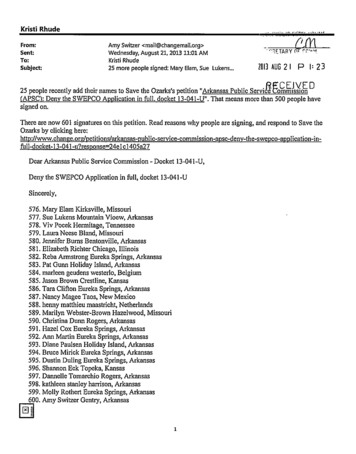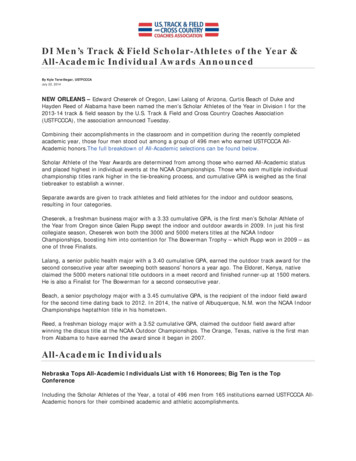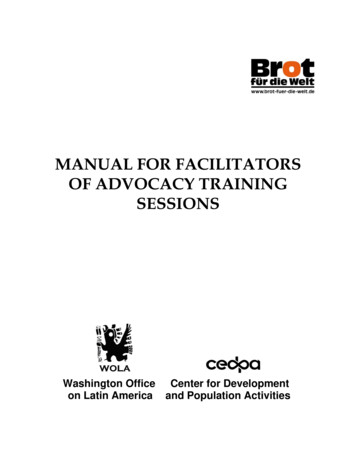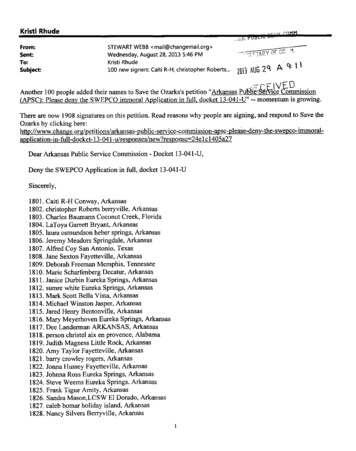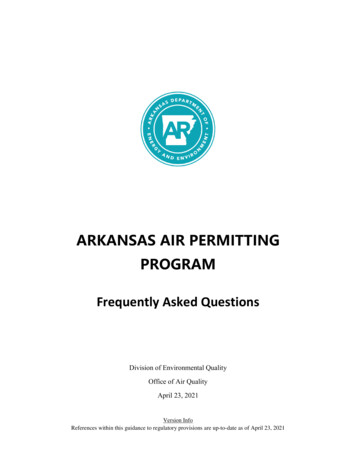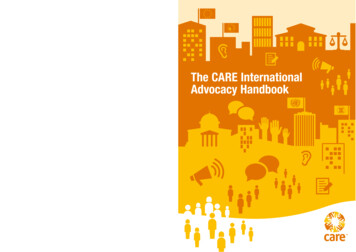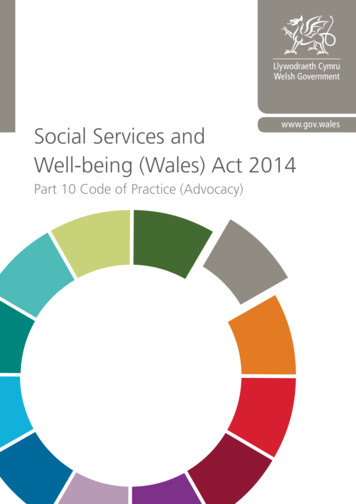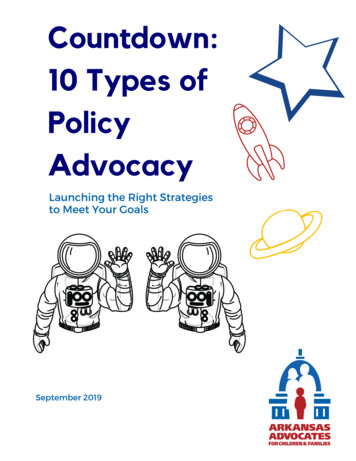
Transcription
Countdown:10 Types ofPolicyAdvocacyLaunching the Right Strategiesto Meet Your GoalsSeptember 2019
CONTENTSPrepared by: Rebecca ZimmermannOutreach DirectorArkansas Advocates for Children and Families1INTRODUCTION2SOCIAL MEDIAADVOCACY4MEDIA ADVOCACY5ELECTION Y10FINANCIAL GAL ADVOCACY15PEER-TO-PEERADVOCACY17HOW A BILL BECOMESA LAW IN ARKANSAS19WORKBOOK
Prepare for LiftoffWhen Arkansas Advocates for Children and Families (AACF)meets with people around the state, we hear similar stories: inEl Dorado and Jonesboro, we hear about the negative impactof unfair rental laws on children’s health. In Springdale andLittle Rock, we're told of the ability of early childhoodeducation to ensure kids’ long-term success. In Russellville andFort Smith, we learn about the damage done to familiesbecause of drug addiction. Statewide solutions are needed formany problems facing kids.Public policy has the power to improve the lives of some700,000 kids who call Arkansas home. If we want to solveproblems and protect solutions, advocacy is the best tool forcreating significant and lasting change to make Arkansas agreat place for children and families. And kids are counting onus to use our voices to speak up for them when importantdecisions are being made at the local, state, and federal level.AACF has created this advocacy handbook to help you in yourpolicy advocacy efforts by providing tools and tips we havelearned in our more than 40 years of advocacy for our state’skids. We hope this book will prove useful in helping youbecome a strong advocate and voice for Arkansas’s kids.1TEN TYPES OF ADVOCACY
10! Social MediaAdvocacyOverview: Social media advocacy is likely the most common type ofadvocacy, but it can be very difficult. People are saturated withmessages online. Making your message stand out among the noisetakes thoughtful planning.When to use: To reach a wide audience. To advocate when you havea small budget. To publicly engage with decision makers. To make viralcampaigns.Ways to use:Educate — to teach people about the problem you are trying toaddress and the solution you are trying to address it with.Fundraise — to encourage individuals to donate to the solution youare supporting.Interact with decision makers — respectfully, ask legislators to votea certain way, share information that will help them decide, askthem why they voted a certain way.Keep up with the conversation — learn what the public, the press,and decision makers are saying about your issue.Share updates — to keep your followers informed on the progressyou are making on your issue.Activate/Motivate — to inspire individuals to take action on yourissue by contacting a legislator, volunteering, donating, etc. Note:to boost Facebook ads that call people to action, you have to gothrough an authentication process with Facebook.2TEN TYPES OF ADVOCACY
Social MediaAdvocacy, ctd.Tips:1Mix messaging — keep people interested and engaged by mixingup messages between education, activation, updates, etc.2Don’t let someone without knowledge or experience plan your socialmedia strategy. Effective social media advocacy takes strategicthinking. You create the plan — let the intern implement it.3Look at what organizations with messages that you haveresponded to are doing online. What made you respond?What techniques can you adopt?4Use images — social media posts with images are more likelyto be shown in someone’s social media feed and more likelyto get people’s attention.ADVOCACY ADS ON FACEBOOKTo run ads related to politics on your Facebook Page, you have to gothrough several steps. Only Page administrators can go through theprocess. First, Facebook confirms the identity and location of the admin.You'll have to provide a US driver's license, state ID card or passport,along with a US-based residential mailing address. Then you have to linkyour ad account(s) to your Page and enter a "Paid for by" disclaimer. Thisprocess can take two weeks or longer, so be sure to complete it well inadvance of any Facebook campaign you plan to do, if it's even remotelyrelated to politics. Search the Facebook Business Ads Help Center for "adsabout social issues, elections or politics" for the full details.3TEN TYPES OF ADVOCACY
9! MediaAdvocacyOverview: Traditional media is not dead. Many people still rely ondigital publications and televised news for information. Educating andactivating through traditional media sources can still be useful.When to use: To educate and activate individuals outside of yourcurrent network. To increase the likelihood of your messages beingseen by decision makers and community influencers.Ways to use:Create news — send press releases when you publish new research;invite press to demonstrations and community meetings.Capitalize off breaking news — if you can act quickly enough,release a statement to the press related to a current news storyCultivate relationships — Send reporters data, tips, and research;and submit opinion pieces and letters to the editor.Train a spokesperson — Have at least one staff person or volunteerwho is comfortable taking interviews, and keep them prepared withrelevant talking points.Tips:41Read through op-eds, watch human interest stories, etc. andidentify what types of information the media is looking forand who they are getting it from.2If you are going to talk about a problem, be sure to haverecommended solutions prepared.TEN TYPES OF ADVOCACY
8! ElectionAdvocacyOverview: Nonprofits CAN participate in election advocacy. But lawsand restrictions apply! (Refer to Arkansas Secretary of State’s Office,the Arkansas Ethics Commission, and the IRS for information on rulesand regulations).When to use: If your mission and issue are affected by decisionsmade by elected officials. If you have a large base of supporters youwant to engage. If you want to ensure your issue is being discussed bycandidates.Ways to use:Host/attend a candidate forum — hosting candidate forums are agreat way to make issues you care about part of the conversationduring the election.Create a Voters’ Guide — Handing voters’ guides out to the generalpublic increases the likelihood of your issues being discussed at arange of election events.Propose a ballot initiative — instead of trying to get a specific pieceof legislation passed through the legislature, you can petition tohave an initiative added to the ballot that would leave it to thevoters to decide on. These efforts can be very expensive though.So, if another group is leading efforts on an initiative that yousupport, consider connecting with them and ask how you can help.Actions you can take as an individual (but not as a 501(c)3nonprofit):Run for officeVolunteer on a campaignEndorse a candidateDonate to a campaign or party5TEN TYPES OF ADVOCACY
ElectionAdvocacy, ctd.CONSIDER THIS:Running a ballot initiative campaign is very time consuming andexpensive. Depending on whether you are proposing a constitutionalamendment or an initiated act you must gather either 84,859 or 67,887signatures respectively to get the measure on the ballot. That takes alot of people power and money. Then promoting the initiativethroughout the state and gaining support can be equally challenge. Ifthis is a route you would like to take, consider partnering with likeminded organizations that may have funded initiatives similar to yours.See the Arkansas Secretary of State’s Office for information on thelaws regarding ballot initiatives.Resources from Bolder Advocacy (https://bolderadvocacy.org):61Comparison of 501(c)(3) and 501(c)(4) permissible activities2Commenting on Candidates and Campaigns3Election Checklist for 501(c)(3) Public Charities: EnsuringElection Year Advocacy Efforts Remain Nonpartisan4The Rules of the Game: A Guide to Election-RelatedActivities for 501(c)(3) OrganizationsTEN TYPES OF ADVOCACY
7! AdministrativeAdvocacyOverview: Passing a law is only the first step. Generally, after thegovernor signs a bill into law, it is sent to the relevant departmentwhere the rules will be promulgated, or, in other words, where the insand-outs of implementation will be decided.When to use: To ensure that a law best assists the people it is meantto serve. To ensure a bad law doesn’t get worse in implementation.Ways to use:Provide public comments — give your written input on how the lawshould be implementedMeet with relevant department heads — share information, data, andstories about your issue that can help them in the rule-making processAttend public rule-making hearings- provide testimony on how the lawshould be implemented through data and storiesTips:71Get in the weeds! This is the time to really get in the weedsand nail down exactly how a law will be implemented. Whatare the on-the-ground details that will affect implementationthat might be overlooked?2Create on-going relationships with relevant department heads.If you already have a relationship, they are more likely to turnto you for insight when a new law comes up in your issue area.3Don’t be intimidated. You are an expert in your field anddecision makers need to hear from you. From their position,there are a lot of important details that can be missed. You canfill-in those gaps.TEN TYPES OF ADVOCACY
6! LegislativeAdvocacyOverview: Legislators hear from many voices when they create a law.They listen to lobbyists, campaign contributors, and their constituents.They get data from experts. They get information from people claimingto be experts. They speak with colleagues, attend committee hearings,and debate bills on the floor. There are plenty of opportunities toadvocate and lobby.When to use: If there is legislation you want proposed. If there is abill that has been filed that helps your issue. If there is a bill that hasbeen filed that will harm your issue.Ways to use:Lobby — ask a legislator to vote a certain way on a specific piece oflegislation or propose certain legislation. Laws apply! (Refer toArkansas Secretary of State’s Office, the Arkansas EthicsCommission, and the IRS for information on rules and regulations.)Advocate — if you don’t want to tell legislators they should vote acertain way, but just want to educate them on your issue, you cando that, too. Or you can do both. Educate them, then lobby them.(Remember laws apply! See above.)See Bolder Advocacy’s worksheet online Public Charities Can Lobby8TEN TYPES OF ADVOCACY
LegislativeAdvocacy, ctd.Tips:1Meet with legislators out of session, as this may allow you moretime to educate a legislator about your issue and help create atrusting relationship between the two of you regarding yoursubject matter. As a result, the legislator may turn to you forinsight and advice when a bill comes up in your issue area.2Learn where legislators stand on your issue through social media,attending committee meetings, and asking colleagues. This canhelp you determine who still needs to be persuaded and who canbe a champion for your cause.3Be respectful. It can be frustrating to hear some of the opinionslegislators have, but being disrespectful won’t get you anywhere.4Stay on top of what is happening at the Capitol. Things can movequickly so follow what is happening on Twitter (follow #arpx and#arleg), sign up for bill tracking on the General Assembly'swebsite, and sign up for alerts on AACF's website.569Stay focused on your mission. Create an agenda of what policy orpolicies you want to work on before you start advocating duringthe session, to keep you focused and on track. The agenda can beused to guide all of your advocacy efforts.Make sure to follow up and thank legislators for taking action onbehalf of your cause.TEN TYPES OF ADVOCACY
5! FinancialAdvocacyOverview: Where you spend your money is an indication of what youvalue. Making campaign contributions or donating to nonprofits can beeffective ways to advance your issue.When to use: To support a candidate or party (not as a nonprofit, onlyas an individual). To support a cause.Ways to use, as an individual:Donate to a political party.Donate to a candidate.Donate to a Political Action Committee (PAC).Donate to a nonprofit.CONSIDER THIS:You worked hard for your money! There are many places where youcan invest. Be thoughtful about which donations and campaigncontributions can really move your issue forward.10TEN TYPES OF ADVOCACY
4! ResearchAdvocacyOverview: Knowledge is power. Ensuring the accuracy of informationis important to advocacy because it’s what advocates use to askdecision makers and stakeholders to support or oppose an issue.When to use: If information is not currently available on your issuearea. If information in your issue area needs to be updated. Ifconclusions drawn by current research are inaccurate or the currentresearch itself is inaccurate. If current research is incomplete. If theuse of data will help you move your issue forward.Ways to use:Conduct your own research from scratch — if there are no data in yourissue area or if the data are not specific to your region or state, you maywant to consider conducting a full-scale research project. This can takeyears depending on the data being collected and whether or not you willanalyze and publish the data.Analyze data sets that already exist — several public institutions houseraw data and make it publicly available. However, the data must beanalyzed to relay compelling stories. You can pull and analyze the datarelevant to your issue to draw conclusions on the need.Fill-in the gaps — if some research exists for your issue area but certainpoints are missing, conduct additional research to deepen the scopeCreate publications or fact sheets so your findings can be used by others.CONSIDER THIS:You may need different levels of specialized knowledge foryour research. Contact local college or university professorsor hire experts to help you conduct the research.11TEN TYPES OF ADVOCACY
3! GrassrootsAdvocacyOverview: There is strength in numbers. And grassroots advocacy isprobably the most powerful form of advocacy because it bringstogether so many voices. It is also the most diverse and complex form ofadvocacy because of the many methods you can use.When to use: If you wish to engage a large number of people. If youwant decision-makers to see the wide support for your issue andsolution. If you want decision makers to see the wide opposition for acurrent law or proposed law. If the problem you want to solve is big.CONSIDER THIS:Plan, plan, plan. There are often intermediate and short-term goals forgrassroots campaigns. But grassroots movements are about the longgame. Decide on a goal and create a strategy to achieve it. Waiting tilldown the road will likely cause division among your supporters.12TEN TYPES OF ADVOCACY
GrassrootsAdvocacy, ctd.Ways to use:Petitions — if you have a large network, petitions, particularly onlineversions, can be an easy way to gather voices in support of oropposition to a current law or proposal.Letters of support — usually signed by representatives oforganizations, letters of support are a great way to illustratesupport for current laws under threat or support for proposed laws.Days at the Capitol — hosting a gathering of your members orsupporters at the state or nation’s Capitol can be a great way toengage your followers, get them excited about advocating, and getthem more comfortable with the legislative process. It also helpsincrease awareness about your issue(s) with lawmakers.Art — community art projects can be a fun, “out-of-the-box” way toraise awareness about your issue. You can host a concert withsongs about your issue or have an art contest with images thatraise awareness about your issue.Letter writing campaigns — lawmakers pay attention to thefeedback they get from their constituents. Encouraging yoursupporters to write to or call their legislators can have a big impact.Marches — can create a powerful visual image about the supportfor your issue. They will likely be picked up by the media and seenby a wide audience.Coalitions — connecting with like-minded individuals who share thesame goal as you can increase the number of people and voicessupporting your cause, as well as the amount of resourcesdedicated to achieving your goal.13TEN TYPES OF ADVOCACY
2! LegalAdvocacyOverview: After a law passes and/or is implemented, legal advocacycan be a last resort option to repeal a law or prevent a law from beingenacted.When to use: If you want to repeal a current law. If you want toprevent a law from being enacted. If you believe a current law is notbeing properly implemented or enforced.Ways to use:File suit — this takes money and legal experts, but you can file alawsuit against the relevant government entity.Write an amicus brief — if you have legal experts on your staff orcan hire legal experts, but you don’t want to file a lawsuit yourself,your legal experts can write a legal opinion supporting a suit thathas been filed by others.Tips:141If you want to file suit, make sure you have enough money. Thistype of litigation can take years and significant financialinvestment. You may also consider jointly suing with otherorganizations so you can gain more resources for the suit.2Make sure you hire the right legal expert. Lawyers are likedoctors. They specialize in certain areas of the law. And justlike you wouldn’t want your dentist to conduct your heartsurgery, you don’t want a Human Resource attorney to leadyour suit about water pollution laws not being enforced.TEN TYPES OF ADVOCACY
1! Peer-to-PeerAdvocacyOverview: Where is the easiest place to start your advocacy? Yourcurrent network! People are much more likely to get involved and takeaction on an issue if someone they know and trust asks them to versus ageneric request from a person or organization they don’t know.When to use: When you want to activate your friend, family andprofessional networks to support and take action for your cause.Ways to use:Get coffee — just like fundraising, advocacy is about relationships.Grab coffee with a friend, ask them what issues they care aboutand tell them about the issue you are working on. Give them a onepager and ideas on ways they can connect with your advocacy.Host a party — throw a house party with your friends, colleagues,and your friend’s friends. Take a few minutes once most peoplehave arrived to talk about your issue and give them an opportunityto meet with current advocates at the party to learn more and findout ways they can take action.Call, text, or email — for those friends that you know won’t take alot of convincing — just give them a quick overview of the issue youare advocating on and how they can help.15TEN TYPES OF ADVOCACY
Peer-to-PeerAdvocacy, ctd.Tips:161Share updates with the people who have helped in youradvocacy, so they can know if more help is needed and theimpact their efforts have had.2Don’t forget to tell your network thank you! Send a thank youto everyone who contacted legislators, shared information onFacebook, volunteered, or attended an event.TEN TYPES OF ADVOCACY
How a Bill Becomes aLaw in Arkansas (WithYour Help)1. Recruit Bill Sponsor. Take your idea to your legislator or a legislator youthink may be passionate about your issue. Have stories and data about theproblem and your proposed solution/idea for a bill. Do this as far in advanceof the legislative session as possible. If one legislator declines, that is OK.Reach out until you find a legislator who connects with the purpose of the billand the people it is meant to serve.2. Stay in Touch. If the legislator is willing to file a bill, keep in touch and askhow you can help. Do you need to reach out to other legislators to ask thatthey co-sponsor? Does the legislator need additional data to file the bill?3. The Bill is Filed. The fall before the legislative session begins, or during thesession, the legislator officially files the bill. Ask the legislator about thetimeline for the bill. Often, even though a bill is filed, it will not immediately beconsidered by the General Assembly.4. The Bill is Considered by the First of Two Committees. The bill is heardin the relevant committee and on the side of the chamber that the bill sponsoris part of. So if the bill sponsor is a House member, it will be heard on theHouse side. Again, make sure to confirm the timeline of the bill with your billsponsor. Just because it is on the agenda to be heard by a committee doesnot mean it will be. Ask your bill sponsor how you can help. They will have thebest idea of what is needed, or not needed, to move the bill forward. Do youneed to recruit people to testify on behalf of the bill? Do you need to create aone-pager for the bill? Do you need to send an alert for people to callcommittee members?17TEN TYPES OF ADVOCACY
How a Bill Becomes aLaw (With Your Help), ctd.5. The Bill is Considered by the First of Two Chambers. If the bill passesout of committee, it will move to the full Chamber of the House or Senate fora vote. Ask the bill sponsor how you can help.6. The Bill is Considered by the Final of Two Committees. The bill will thenmove to a committee in the opposite chamber. Usually it will be in acorresponding committee. For instance, if it is heard in the House EducationCommittee, it will be heard in the Senate Education Committee. But there arerare exceptions. Check with the bill sponsor about which committee it will beheard in, and ask the bill sponsor how you can help.7. The Bill is Considered by the Final of Two Chambers. If the bill passesout of the second committee, it will go to the final chamber. Ask the billsponsor how you can help. Even if there is nothing directly you can do to helpand you think it is likely to pass, it is always nice to invite supporters of yourbill to watch the final vote in person or online to celebrate. If the bill wasamended in this chamber, it will then go back to steps 4 and 5 to be heard bythe first chamber again, as amended.8. The Bill is Signed Into Law by the Governor. If the bill passes bothcommittees and chambers, it will go to the Governor’s desk for her/his/theirsignature. It is very rare that a bill passes through the General Assembly anddoes not get signed by the Governor. So the bill sponsor would most likely notneed help at this stage. Confirm with the bill sponsor when the bill will besigned by the Governor, and ask if you can invite your fellow advocates andthe press to celebrate!9. You Thank Legislators. Make sure to personally and publicly thank thelegislator(s) who sponsored the bill, and ask others in your network to thankthe bill sponsor(s), too.18TEN TYPES OF ADVOCACY
It's notRocketScience!Policy Advocacy CampaignPlan WorkbookSeptember 2019Prepared by: Rebecca ZimmermannOutreach DirectorArkansas Advocates for Children and Families
AdvocacyCampaign TemplateI. Problem Statement and Solution (What specific problem are you trying toaddress and what specific solution are you proposing? And if funding isrequired, how specifically it will be paid for?)a. Problem:b. Solution:II. Goals (Besides getting legislation passed or bad legislation thwarted, whatother goals do you have for your campaign? Raise awareness about yourissue? Have a certain number of people call legislators? Get a certain amountof news organizations to write about your issue?)a. Primary:b. Secondary:20TEN TYPES OF ADVOCACY
AdvocacyCampaign Template, ctd.III. Allies, Opposition, Targetsa. Active Allies (Who are people or organizations that will actively help withyour campaign? And how will they help — by educating/lobbying legislators,hosting events, sending alerts, etc.?)i.ii.iii.b. Passive Allies (Who are people or organizations who are supportive of yourgoal, but for whatever reason cannot or will not put resources behindsupporting it?)i.ii.iii.c. Active Opposition (Who are people or organizations who do not want tosee your goal achieved and will put resources behind stopping it?)i.ii.iii.d. Uncommitted (Who are people or organization that you would like toengage on your goal but have not decided if they will?)i.ii.iii.21TEN TYPES OF ADVOCACY
AdvocacyCampaign Template, ctd.IV. Legislative Strategya. Background (What is the overall reasoning for the strategy you havechosen?)b. Potential Champions (Who are legislators likely to sponsor and/or championlegislation in both chambers and could move the legislation through the GeneralAssembly?)c. Potential Opposition (Who are legislators that are likely to oppose thelegislation? And will they do so actively – meaning will they try to getcolleagues to also oppose the legislation?)d. Targets (Who are specific legislators who are on the fence that needadditional advocacy? Which committees will the bill be heard in, and who arethe committee members?)e. Influencers (Who are other legislators or community/business leaders whomight be influential in moving or hindering the legislation?)f. Whose responsibility is it to educate/lobby legislators and the Governor’soffice?22TEN TYPES OF ADVOCACY
AdvocacyCampaign Template, ctd.V. Communications Plana. Core Messagesb. Key Facts/Data Pointsc. Audiencesd. Messengerse. Platforms/Mediaf. Who is responsible for communications?23TEN TYPES OF ADVOCACY
AdvocacyCampaign Template, ctd.VI. Outreach Plana. Targets (Who do you want to activate to contact legislators about yourgoal? Specific types of people, like moms? Specific networks of people, like adoctor’s association? People in specific parts of the state?)i.ii.iii.b. Mobilization/Engagement (How will you activate them – create a coalition,outreach events, legislative alerts, partner networks, direct requests, etc.? Howwill you make sure everyone stays on message?)i.ii.iii.c. Who is responsible for outreach?24TEN TYPES OF ADVOCACY
AdvocacyCampaign Template, ctd.VII. Timeline: Activities and Reports (Timeline of publications, articles,outreach events, lobbying efforts, etc. Tip: start your activities as far inadvance as possible, a lot of decisions about legislation are already madebefore the General Assembly convenes).VIII. Budget25TEN TYPES OF ADVOCACY
Arkansas Advocates for Children and Families1400 West Markham, Suite 306Little Rock, AR 72201(501) 371-9678Northwest Arkansas Office614 East Emma Avenue, Suite 235Springdale, AR 72764(479)-927-9800LEARN MORE AT .com/aacfinstagram.com/aradvocates
10! Social Media Advocacy Overview: Social media advocacy is likely the most common type of advocacy, but it can be very difficult. People are saturated with messages online. Making your message stand out among the noise takes thoughtful planning. When to use: To reach a wide audience. To advocate when you have a small budget.
